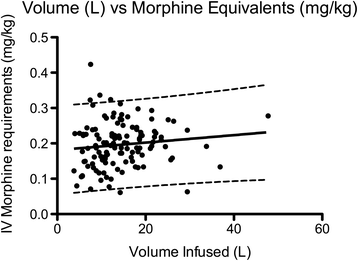Surgical predictors of acute postoperative pain after hip arthroscopy
- PMID: 26135315
- PMCID: PMC4489023
- DOI: 10.1186/s12871-015-0077-x
Surgical predictors of acute postoperative pain after hip arthroscopy
Abstract
Background: Pain following hip arthroscopy is highly variable and can be severe. Little published data exists demonstrating reliable predictors of significant pain after hip arthroscopy. The aim of this study was to identify influence of intraoperative factors (arthroscopic fluid infusion pressure, operative type) on the severity of postoperative pain.
Methods: A retrospective review of 131 patients who had received a variety of arthroscopic hip interventions was performed. A standardized anaesthetic technique was used on all patients and postoperative pain was analysed using recovery pain severity outcomes and analgesic use. A multivariate logistic regression analysis was performed on intraoperative factors including patient age, sex and BMI, arthroscopic infusion pressures (40 vs 80 mm Hg), amount of fluid used, length of surgery and types of arthroscopic interventions performed. Thirty six patients were also prospectively examined to determine arthroscopic fluid infusion rates for 40 and 80 mm Hg infusion pressures.
Results: Use of a higher infusion pressure of 80 mm Hg was strongly associated with all pain severity endpoints (OR 2.8 - 8.2). Other significant factors included hip arthroscopy that involved femoral chondro-ostectomy (OR 5.8) and labral repair (OR 7.5). Length of surgery and total amount of infusion fluid used were not associated with increased pain.
Conclusions: 80 mm Hg arthroscopic infusion pressures, femoral chondro-osteoectomy and labral repair are strongly associated with significant postoperative pain, whereas intraoperative infusion volumes or surgical duration are not. Identification of these predictors in individual patients may guide clinical practice regarding the choice of more invasive regional analgesia options. The use of 40 mm Hg arthroscopic infusion pressures will assist in reducing postoperative pain.
Figures



Similar articles
-
Diagnosis of Intraabdominal Fluid Extravasation After Hip Arthroscopy With Point-of-Care Ultrasonography Can Identify Patients at an Increased Risk for Postoperative Pain.Anesth Analg. 2017 Mar;124(3):791-799. doi: 10.1213/ANE.0000000000001435. Anesth Analg. 2017. PMID: 27551733
-
Arthroscopic capsular plication and labral preservation in borderline hip dysplasia: two-year clinical outcomes of a surgical approach to a challenging problem.Am J Sports Med. 2013 Nov;41(11):2591-8. doi: 10.1177/0363546513499154. Epub 2013 Aug 16. Am J Sports Med. 2013. PMID: 23956133
-
Intra-abdominal fluid extravasation during hip arthroscopy: a survey of the MAHORN group.Arthroscopy. 2012 Nov;28(11):1654-1660.e2. doi: 10.1016/j.arthro.2012.04.151. Epub 2012 Sep 16. Arthroscopy. 2012. PMID: 22989716
-
The hip joint: arthroscopic procedures and postoperative rehabilitation.J Orthop Sports Phys Ther. 2006 Jul;36(7):516-25. doi: 10.2519/jospt.2006.2138. J Orthop Sports Phys Ther. 2006. PMID: 16881468 Review.
-
Multicenter Outcomes After Hip Arthroscopy: Epidemiology (MASH Study Group). What Are We Seeing in the Office, and Who Are We Choosing to Treat?Am J Orthop (Belle Mead NJ). 2017 Jan/Feb;46(1):35-41. Am J Orthop (Belle Mead NJ). 2017. PMID: 28235111 Review.
Cited by
-
Retrospective Comparison of Quadratus Lumborum and Pericapsular Nerve Group Blocks for Postoperative Pain Management of Patients Undergoing Outpatient Hip Arthroscopy.J Pain Res. 2024 Sep 28;17:3157-3166. doi: 10.2147/JPR.S466694. eCollection 2024. J Pain Res. 2024. PMID: 39363949 Free PMC article.
-
Increased Length of Surgery Is Associated With Increased Fluid Pump Pressure During Hip Arthroscopy.Orthop J Sports Med. 2025 Jun 11;13(6):23259671251342584. doi: 10.1177/23259671251342584. eCollection 2025 Jun. Orthop J Sports Med. 2025. PMID: 40519543 Free PMC article.
-
Perioperative pain management in hip arthroscopy; what options are there?J Hip Preserv Surg. 2016 May 13;3(3):181-9. doi: 10.1093/jhps/hnw015. eCollection 2016 Aug. J Hip Preserv Surg. 2016. PMID: 27583156 Free PMC article. Review.
-
Predictors for Moderate to Severe Acute Postoperative Pain after Cesarean Section.Pain Res Manag. 2016;2016:5783817. doi: 10.1155/2016/5783817. Epub 2016 Nov 10. Pain Res Manag. 2016. PMID: 27956847 Free PMC article.
-
Prospective, Observational Study of Opioid Use After Hip Arthroscopy for Femoroacetabular Impingement Syndrome.Arthroscopy. 2018 May;34(5):1488-1497.e6. doi: 10.1016/j.arthro.2017.12.005. Epub 2018 Feb 2. Arthroscopy. 2018. PMID: 29398210 Free PMC article.
References
MeSH terms
LinkOut - more resources
Full Text Sources
Other Literature Sources

